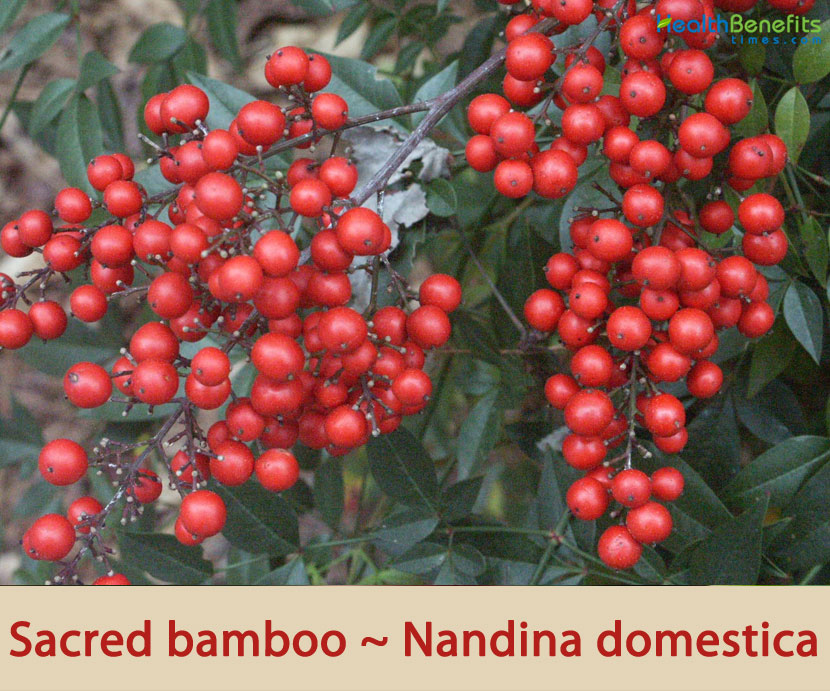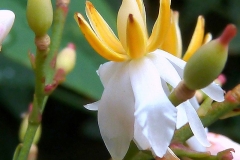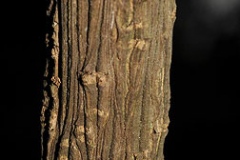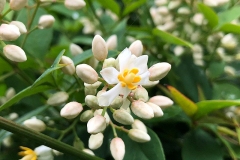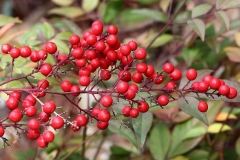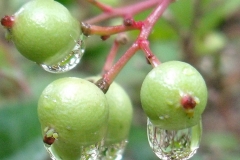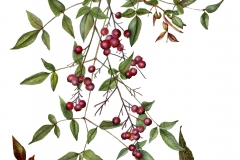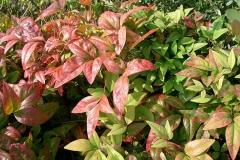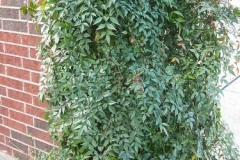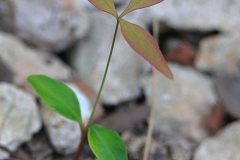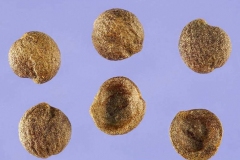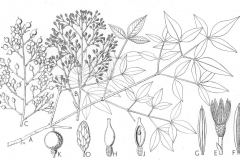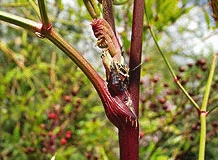| Sacred bamboo Quick Facts | |
|---|---|
| Name: | Sacred bamboo |
| Scientific Name: | Nandina domestica |
| Origin | Eastern Asia, occurring in India, Japan, and China. |
| Colors | Green berries that mature to a Bright red to purplish |
| Shapes | Ovoid to globose, shiny red berries, 5–10 mm diameter |
| Health benefits | Good for acute bronchitis, whooping cough, indigestion, acute gastro-enteritis, tooth abscess, pain in the bones and muscles and traumatic injuries |
| Name | Sacred bamboo |
|---|---|
| Scientific Name | Nandina domestica |
| Native | Eastern Asia, occurring in India, Japan, and China. Occasionally naturalized in some parts of central and northern New South Wales and sparingly naturalized in south-eastern Queensland. Also naturalised in large parts of south-eastern USA (i.e. Texas, Louisiana, Mississippi, Alabama, Florida, Georgia, South Carolina, North Carolina and Virginia) |
| Common Names | Nandina, Chinese-bamboo, Heavenly-bamboo, Sacred-bamboo, Southern heaven-bamboo, Sacred bamboo, Heavenly bamboo, Nanten, Japanese sacred bamboo, sacred Japanese bamboo |
| Name in Other Languages | Afrikaans: Nandina, Japanese bamboes Albanian: Nandina Amharic: Nanidīna (ናንዲና) Arabic: Nandina (ناندينا) Armenian: Nanda (նանդա) Azerbaijani: Nandina Bengali: Nandina Brazil: Avenca-japonêsa, bambu-celeste, bambu-do-céu Bulgarian: Nandina Burmese: Nandina Chinese: Nán dí nà (南迪娜), nan tian zhu (南天竹) Croatian: Nandina Czech: Nandina Danish: Nandina Dutch: Nandina English: Nandina, Chinese-bamboo, Heavenly bamboo, Sacred bamboo, Southern heaven-bamboo, nanten Esperanto: Nederlandano Estonian: Nandina Filipino: Nandina Finnish: Nandina French: Nandina, Nandine fruitiere Georgian: Nandingi (ნანდინგი) German: Nandina, Garten- Nandine Greek: Nantína (Ναντίνα) Gujarati: Nandīnā (નંદીના) Hausa: Nandina Hebrew: ננדינה Hindi: Nandina Hungarian: Nandina Icelandic: Nandina Indonesian: Nandina Irish: Nandina Italian: Nandina Japanese: Nandina (ナンディナ), nanten (ナンテン) Javanese: Nandina Kannada: Nandinā (ನಂದಿನಾ) Kazakh: Nandina (нандина) Korean: Nan dina (난 디나), nam cheon (남천) Kurdish: Nandina Lao: Nandina Latin: Nandina Latvian: Nandina Lithuanian: Nandina Macedonian: Nondiranje (нондирање) Malagasy: Nandina Malay: Nandina Malayalam: nandina (നന്ദിന) Maltese: Nandina Marathi: Nandina (नंदिना) Mongolian: Nandina (нандина) Nepali: Nānadinā (नानदिना) Norwegian: Nandina Oriya: ନନ୍ଦିନୀ ଫୋଟିନିଆ Pashto: ناندینا فوټینیا Polish: Nandina Portuguese: Nandina Punjabi: Nadinā (ਨੰਦਿਨਾ) Romanian: Nandina Russian: Nandina Serbian: Nandina (нандина) Sindhi: نيندينا Sinhala: Nandina (නන්දිනා) Slovenian: Nandina Spanish: Nandina, bambu celestial, bambu sagrado Sudanese: Nandina Swedish: Nandina Tajik: Nandina (нандина) Tamil: Nantiṉā (நந்தினா) Telugu: Nandina Thai: Nandina Turkish: Nandina Ukrainian: Nandina Urdu: نندینا Uzbek: Nandina Vietnamese: Nandina Welsh: Nandina Zulu: Nandina |
| Plant Growth Habit | An erect, evergreen or semi-evergreen, broadleaf, many stemmed, woody shrub |
| Growing Climates | Woodland, floodplains, forest edges, ravines and valleys in mountains and warmer parts, stream sides in montane forests, roadsides, and thickets. It is found in disturbed and undisturbed upland hardwood and upland mixed forests, riparian forests, slope woodlands, urban woodlands. It rarely occurs in early successional communities, but can grow in full sun and along forest edges |
| Soil | Tolerates a wide range of soil characteristics but prefers moist, well-drained fertile soil |
| Plant Size | 5 to 7 feet high and spreads 3 to 5 feet |
| Bark | Brown, splitting into shallow ridges and furrows |
| Stem | Erect, one to several growing from a clump, and usually unbranched, although new stems formed at the base of the clump may produce a broad colony of stems. Stems reddish at first, maturing light brown in color |
| Leaf | Alternate, glossy, smooth, bi- to tripinnately compound, and green, sometimes reddish or burgundy. Petiole bases clasp the stem. Leaves are 1 to 3 feet long and wide, each leaflet elliptic-lanceolate and ¾ to 3 inches long. Leaflets are sub sessile with entire margins |
| Flowering season | May to July |
| Flower | Flowers are ¼ to ½ inches across, bisexual, pinkish in bud, maturing to white, tri-merous, pedicellate, sepals many, arranged spirally. Petals are variable in number ranging from 2 to 6 and are bigger than sepals, without glands. |
| Fruit Shape & Size | Ovoid to globose, shiny red berries, 5–10 mm diameter |
| Fruit Color | Green berries that mature to a Bright red to purplish |
| Seed | Seeds 1-3, grayish brown |
| Plant Parts Used | Roots, leaves, and fruits |
| Propagation | Spreads both vegetatively through underground sprouts from roots and by seeds |
| Season | October – December |
Plant Description
Sacred bamboo is an erect, evergreen or semi-evergreen, broadleaf, many stemmed woody shrub that is ornamentally grown for its interesting foliage and its often remarkable fruit display. It is a graceful, fine-textured evergreen shrub, rather than a true bamboo. The plant typically grows about 5 to 7 feet tall and 3 to 5 feet wide. It grows 12 to 24 inches per year, depending on conditions, including location, light, fertility and water. In St. Louis, it is semi-evergreen to deciduous, and typically grows shorter since the stems often will die to the ground in winter.
The plant is found growing in woodland, floodplains, forest edges, ravines and valleys in mountains and warmer parts, stream sides in montane forests, roadsides, and thickets. It is found in disturbed and undisturbed upland hardwood and upland mixed forests, riparian forests, slope woodlands, urban woodlands. It rarely occurs in early successional communities, but can grow in full sun and along forest edges. The plant tolerates a wide range of soil characteristics but performs best in rich, moist, well-drained fertile soil and full sun, which encourages the best growth, foliage color, and fruit set. Plant this shrub in groups to get the best fruiting. Although it does best with consistent watering, sacred bamboo can tolerate some drought after it’s established.
Stem
Stubby branches whorled alternately up the stem and tightly stacked near terminals for a given year’s growth. The overlapping sheaths on the main stem give the appearance of bamboo (thus, the common name). Stem is fleshy and greenish gray near terminal, becoming woody barked and tan to brown with fissures towards the base. Wood is bright yellow colored.
Leaves
Alternate, glossy leaves are occasionally deciduous in colder areas. The young leaves in spring are brightly colored pink to red before turning green. Old leaves turn red or purple again before falling. Its petiolate leaves are 50–100 cm long, compound (two or three pinnacles) with each leaflet, elliptical to ovate or lanceolate and sub sessile with entire margins, 2–10 cm long and 0.5–2 cm wide, with petioles swollen at their bases. Petiole bases clasp the stem.
| Leaf arrangement | Alternate |
| Leaf type | Tripinnately compound |
| Leaf margin | Entire |
| Leaf shape | Lanceolate |
| Leaf venation | Pinnate; reticulate |
| Leaf type and persistence | Evergreen |
| Leaf blade length | 2 to 4 inches |
| Leaf color | Purple or red |
| Fall color | Red |
| Fall characteristic | Showy |
Flowers
The flowers appear from May to July and are pinkish white. Flowers are in terminal, or sometimes axillary, panicles 8 to 15 inches long with numerous perfect hermaphrodite flowers at the end of the branches. Flowers are ¼ to ½ inches across, bisexual, pinkish in bud, maturing to white, tri-merous, pedicellate, sepals many, arranged spirally. Petals are variable in number ranging from 2 to 6 and are bigger than sepals, without glands. Stamens 6, anthers longitudinally dehiscing, ovary superior, ellipsoid, ovules few, basal, style short, persistent in fruit, stigma. Flowers are fragrant.
| Flower color | White |
| Flower characteristic | Spring flowering |
Fruit
If plants are grouped, ovoid, shiny red berries, 5–10 mm diameter, follow the flowers in September and persist into and through the winter. Single plants seldom fruit heavily. At first fruit are green, but mature to bright red, with two grayish brown hemispherical seeds. Seeds are viable, but can be slow to germinate.
| Fruit shape | Round |
| Fruit length | Less than .5 inch |
| Fruit cover | Fleshy |
| Fruit color | Red |
| Fruit characteristic | Persists on the plant; attracts birds |
Traditional uses and benefits of Sacred Bamboo
- The roots and stems are antitussive, anti-rheumatic, astringent, febrifuge, stomachic and tonic.
- Decoction is used in the treatment of fever in influenza, acute bronchitis, whooping cough, indigestion, acute gastro-enteritis, and tooth abscess, pain in the bones and muscles and traumatic injuries.
- It is especially useful in the treatment of children’s coughs.
- Decoction of the leaves is tonic.
- The fruit is febrifuge and tonic.
- Tonics derived from the bark and root-bark is used for eye conditions, flu, muscle pain, rheumatism, gastrointestinal maladies and fever.
- Fruit is used for cough, asthma, whooping cough, malaria, and penile ulcers.
- Fruit is used to treat cough and breathing difficulties in Japan.
- Fruits are used for treatment of tumors and tooth abscesses in Japanese and Chinese traditional medicine.
- Traditionally, a gourd-shaped charm of the wood was made and hung around the neck of a child to ward-off whooping cough.
- They are also said to be useful in restoring the nervous system, quieting drunkards, and have been used as an antidote to Herbal Emissaries: Bringing Chinese Herbs to the West fish poisoning.
- Folk tradition holds that the seeds increase virility.
- Leaves are used for the common cold, whooping cough, red eye, swelling with pain, scrofula, bloody urine, and infantile malnutrition.
- Root is used for headache due to wind and heat, cough due to lung heat, jaundice, with wetness and heat, rheumatism with pain, red eyes, carbuncle and furuncles, and scrofula.
- Root and stem is used for fevers, the common cold, conjunctivitis, cough due to lung heat, jaundice with wetness heat, acute gastroenteritis, infection of the urinary tract, and traumatic injuries.
- Dried berries are used to cure a cough in traditional Chinese medicine.
Other Facts
- Sacred bamboo is a popular ornamental plant.
- It has been cultivated for the medicinal properties of its leaves and berries.
- The aromatic twigs may be used as toothpicks or toothbrushes.
- The plant is used to create sustainable bamboo products as a climate friendly alternative to plastics.
- Preparation of the whole plant is used as an herbal pesticide to control aphids in China.
- Plants are used for hedging in warm temperate zones.
- It is considered a symbol of good luck in Japan and China.
- Ancient ben-cao mentions the planting of sacred bamboo in gardens to prevent fire.
- Historically, it has also been planted next to wash-basins in Japanese gardens to protect against evil.
Precautions
- The fruit is poisonous.
- All parts of the plant are poisonous, containing compounds that decompose to produce hydrogen cyanide, and could be fatal if ingested.
- Excessive consumption of the berries will kill birds such as cedar waxwings, because they are subject to cyanide toxicosis, resulting in death to multiple individuals at one time.
- There is a danger that an overdose can cause respiratory paralysis.
Prevention and Control
Due to the variable regulations around (de)registration of pesticides, your national list of registered pesticides or relevant authority should be consulted to determine which products are legally allowed for use in your country when considering chemical control. Pesticides should always be used in a lawful manner, consistent with the product’s label.
Public Awareness
Several southeastern states of the USA list N. domestica as a potentially invasive plant on web sites and in informational brochures.
Eradication
Because naturalized populations are generally small, they could be eradicated locally. The plant is widely used in landscaping, however, and new populations are likely to occur.
Cultural Control and Sanitary Measures
In areas where N. domestica is invasive, it is recommended to limit new plantings and remove existing plantings or cut off fruits. When plants are transported or removed plants, care is needed not to spread seeds.
Cultural/Physical
Plant the native or non-invasive alternatives. Inform the public to refrain from purchasing, propagating, or planting sacred bamboo due to its ability to escape from cultivation.
Mechanical
Hand pulls the smaller infestations careful to remove all fragments of root to prevent re-infestation. Frequent mowing will be effective but the plant may continue to spread via underground runners.
Movement Control
Care should be taken to contain seeds when moving plants.
Biological Control
Although N. domestica is occasionally attacked by insects and pathogens, none of these are considered for use as biological controls.
Chemical Control
Spot treatments of glyphosate or triclopyr are effective at killing N. domestica. Plants can be sprayed with glyphosate between August and October in the southeastern USA, or tall plants can be cut and the stumps treated with herbicide. In winter, plants can be killed using a basal bark treatment of herbicide in oil.
References:
https://www.itis.gov/servlet/SingleRpt/SingleRpt?search_topic=TSN&search_value=18848#null
http://www.hear.org/pier/species/nandina_domestica.htm
https://pfaf.org/user/Plant.aspx?LatinName=Nandina+domestica
https://www.missouribotanicalgarden.org/PlantFinder/PlantFinderDetails.aspx?kempercode=c772
https://en.wikipedia.org/wiki/Nandina
https://www.cabi.org/isc/datasheet/35692
https://gd.eppo.int/taxon/NANDO
https://indiabiodiversity.org/species/show/230423
http://www.theplantlist.org/tpl1.1/record/kew-2380006
http://www.stuartxchange.com/Nandina.html
https://plants.usda.gov/home/plantProfile?symbol=NADO


